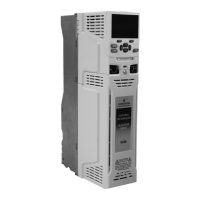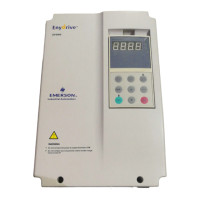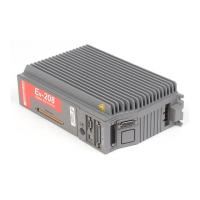Safety
information
Product
information
Mechanical
installation
Electrical
installation
Getting
started
User Menu A Commissioning
Advanced
Parameters
Diagnostics Optimization CT MODBUS RTU Technical Data
248 E300 Design Guide
Issue Number: 1
Apply Frequency (D09), but the motor is not required to stop (i.e. reversing direction without stopping) then Reference On (D10) will be one, and so
the brake is not applied. This prevents the brake from activating and de-activating as the motor passes through zero speed. If the frequency falls
below Brake Control: Brake Apply Frequency (D09) and Reference On (D10) = 0 then the brake will be applied.
Open-Loop
The frequency comparator is used on starting, to detect when the motor frequency has reached a level where the motor can produce the required
amount of torque to ensure that the motor rotates in the demanded direction when the brake is released. Brake Control: Brake Release Frequency
(D08) should be set to a level slightly above the motor slip frequency that is likely to occur under the highest expected load that is applied to the motor
when the brake is released.
The brake apply frequency threshold is used to ensure that the brake is applied before the motor frequency reaches zero and to prevent the motor
rotating (in the reverse direction due to an overhauling load for example) during the brake apply time. If the frequency falls below Brake Control: Brake
Apply Frequency (D09), but the motor is not required to stop (i.e. reversing direction without stopping) then Reference On (D10) will be one, and so
the brake is not applied. This prevents the brake from activating and de-activating as the motor passes through zero speed. If the frequency falls
below Brake Control: Brake Apply Frequency (D09) and Reference On (D10) = 0 then the brake will be applied.
RFC-A, RFC-S
The speed comparator is used on starting, to detect when the motor speed has reached a level where the motor can produce the required amount of
torque to ensure that the motor rotates in the demanded direction when the brake is released. Brake Control: Brake Release Speed (D08) should be
set to a level slightly above the motor slip frequency that is likely to occur under the highest expected load that is applied to the motor when the brake
is released.
The brake apply speed threshold is used to ensure that the brake is applied before the motor speed reaches zero and to prevent the motor rotating (in
the reverse direction due to an overhauling load for example) during the brake apply time. If the speed falls below Brake Control: Brake Apply Speed
(D09), but the motor is not required to stop (i.e. reversing direction without stopping) then Reference On (D10) will be one, and so the brake is not
applied. This prevents the brake from activating and de-activating as the motor passes through zero speed. If the speed falls below Brake Control:
Brake Apply Speed (D0
9) and
Reference On (D10) = 0 then the brake will be applied.
Reference On (D10), which is controlled by the drive sequencer, indicates that the reference from the reference system is active.
When set to Off (0), brake contact monitoring is disabled.
When set to On (1), brake contact 1 monitoring is enabled where Brake Contact Monitoring Input 1 (D12) is monitored to determine the state of the
contactor. It is assumed that if Brake Contact Monitoring Input 1 (D12) = Off (0) the contact is open (brake applied), and if Brake Contact Monitoring
D09
D09
Brake Control: Brake Apply Frequency [Open-Loop]
Brake Control: Brake Apply Frequency [RFC-A, RFC-S]
Mode Open Loop, RFC-A, RFC-S
Minimum 0.0 Maximum
Open-Loop: 20.0
RFC-A, RFC-S: 200
Default
Open-Loop: 2.0
RFC-A, RFC-S: 5
Units
Open-Loop: Hz
RFC-A, RFC-S: rpm
Type 8 Bit User Save Update Rate 4 ms read
Display Format Standard Decimal Places 1
Coding RW, BU
D10 Reference On
Mode Open Loop, RFC-A, RFC-S
Minimum 0 Maximum 1
Default Units
Type 1 Bit Volatile Update Rate 2 ms write
Display Format Standard Decimal Places 0
Coding RO, ND, NC, PT
D11 Brake Contact Monitoring Select
Mode Open Loop, RFC-A, RFC-S
Minimum 0 Maximum 2
Default 0 Units
Type 8 Bit User Save Update Rate Background
Display Format Standard Decimal Places 0
Coding RW, TE, BU
Value Text
0 None
1IP 1
2IP 1 + IP2

